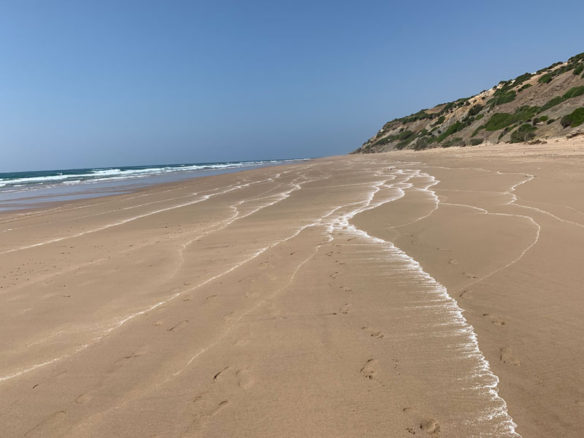
White stripes of decomposed styrofoam on the beach.
Captions and Photo: © SAF — Coastal Care
Excerpts;
Signs of climate change are everywhere, but sometimes those signs are very hard to see. Tiny, nearly invisible pieces of plastic called microplastics are making their way through our ecosystem. The results could be devastating…
Read Full Article; CBS News (11-08-2019)
Four billion particles of microplastics discovered in major body of water; Science Daily (09-12-2019)
While collecting water samples and plankton, researchers discovered a high concentration of microplastics, which are known to disrupt the marine food chain…
People may be breathing in microplastics, health expert warns; Guardian UK (05-10-2016)
People could be breathing in microparticles of plastic, according to a leading environmental health expert, with as yet unknown consequences on health…
Americans Consume Tens of Thousands of Microplastic Particles Every Year; Yale E360 (06-05-2019)
Americans consume more than 70,000 microplastic particles every year from the food they eat, the water they drink, and the air they breathe, according to a new study published in the journal Environmental Science & Technology. Scientists warn that while the health impacts of ingesting these tiny particles are largely unknown, there is potential for the plastic to enter human tissues and cause an immune response, as well as release toxic chemicals into the body…
Sea salt around the world is contaminated by plastic, studies show; Guardian UK (09-08-2017)
New studies find microplastics in salt from the US, Europe and China, adding to evidence that plastic pollution is pervasive in the environment…
Video captures moment plastic enters food chain, BBC News (03-11-2017)
A scientist has filmed the moment plastic microfibre is ingested by plankton, illustrating how the material is affecting life beneath the waves. The footage shows one way that plastic waste could be entering the marine and global food chain…
Microplastic pollution in oceans is far worse than feared, say scientists; Guardian UK (03-12-2018)
Microplastics Have Invaded The Deep Ocean — And The Food Chain; NPR (06-06-2019)
Microplastics in the Great Lakes: Becoming benthic; Science Daily (09-23-2019)
From the Great Pacific garbage patch to inland rivers, plastics are among the most widespread contaminants on Earth. Microplastics — particles of plastic smaller than five millimeters — are especially pervasive. As they build up in Earth’s waters, microplastics are also becoming a permanent part of the planet’s sedimentary layers…
Microplastics pollute most remote and uncharted areas of the ocean; Guardian UK (02-12-2018)
First data ever gathered from extremely remote area of the South Indian Ocean has a surprisingly high volume of plastic particles, say scientists. Currently scientists can only account for 1% of the plastic they think is in the ocean…
The biggest source of microplastics in California coastal waters? Car tires; CNN (10-05-2019)
Plastic Pollution: “When The Mermaids Cry: The Great Plastic Tide,” Coastal Care
Plastic is versatile, lightweight, flexible, moisture resistant, strong, and relatively inexpensive. Those are the attractive qualities that lead us, around the world, to such a voracious appetite and over-consumption of plastic goods. However, durable and very slow to degrade, plastic materials that are used in the production of so many products all, ultimately, become waste with staying power. Our tremendous attraction to plastic, coupled with an undeniable behavioral propensity of increasingly over-consuming, discarding, littering and thus polluting, has become a combination of lethal nature…









